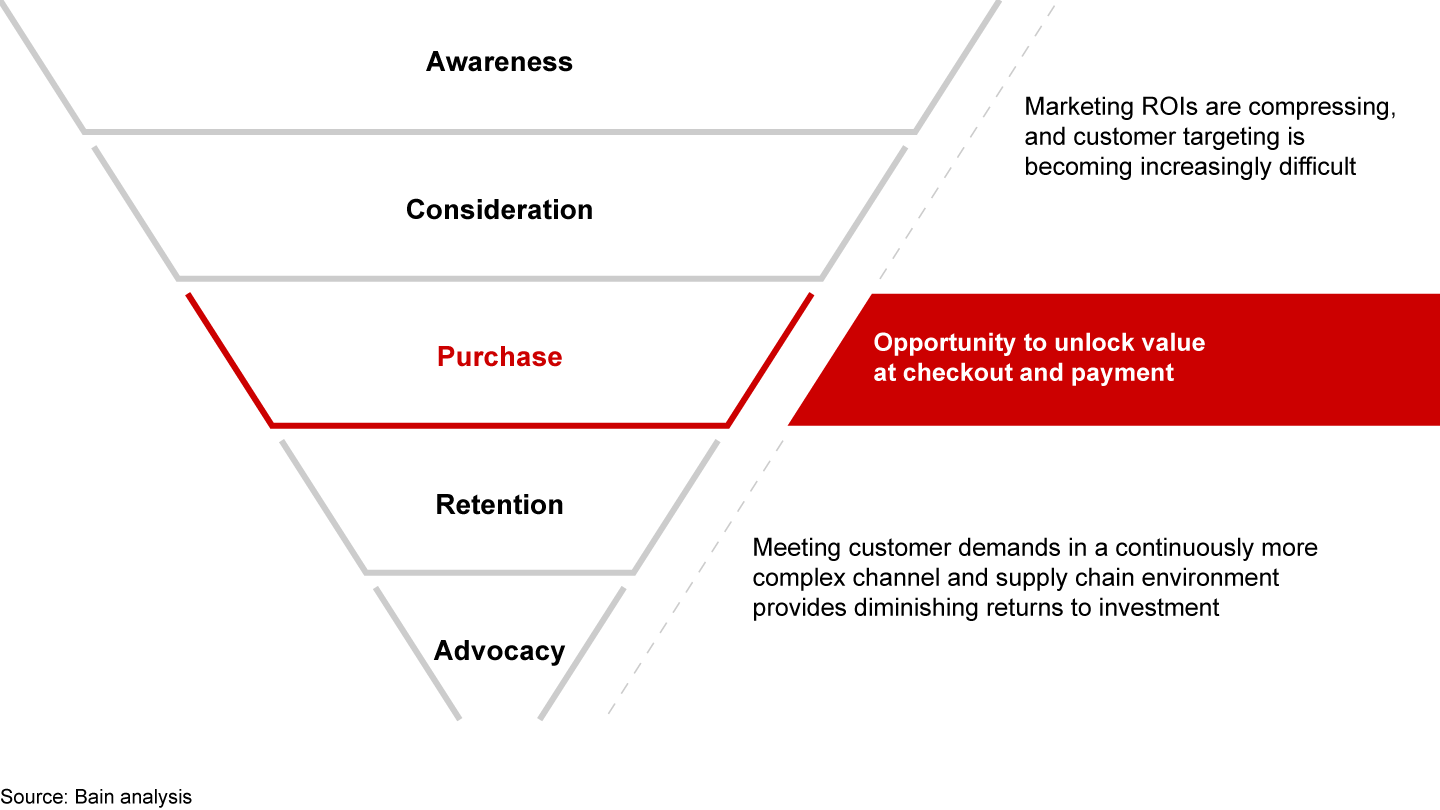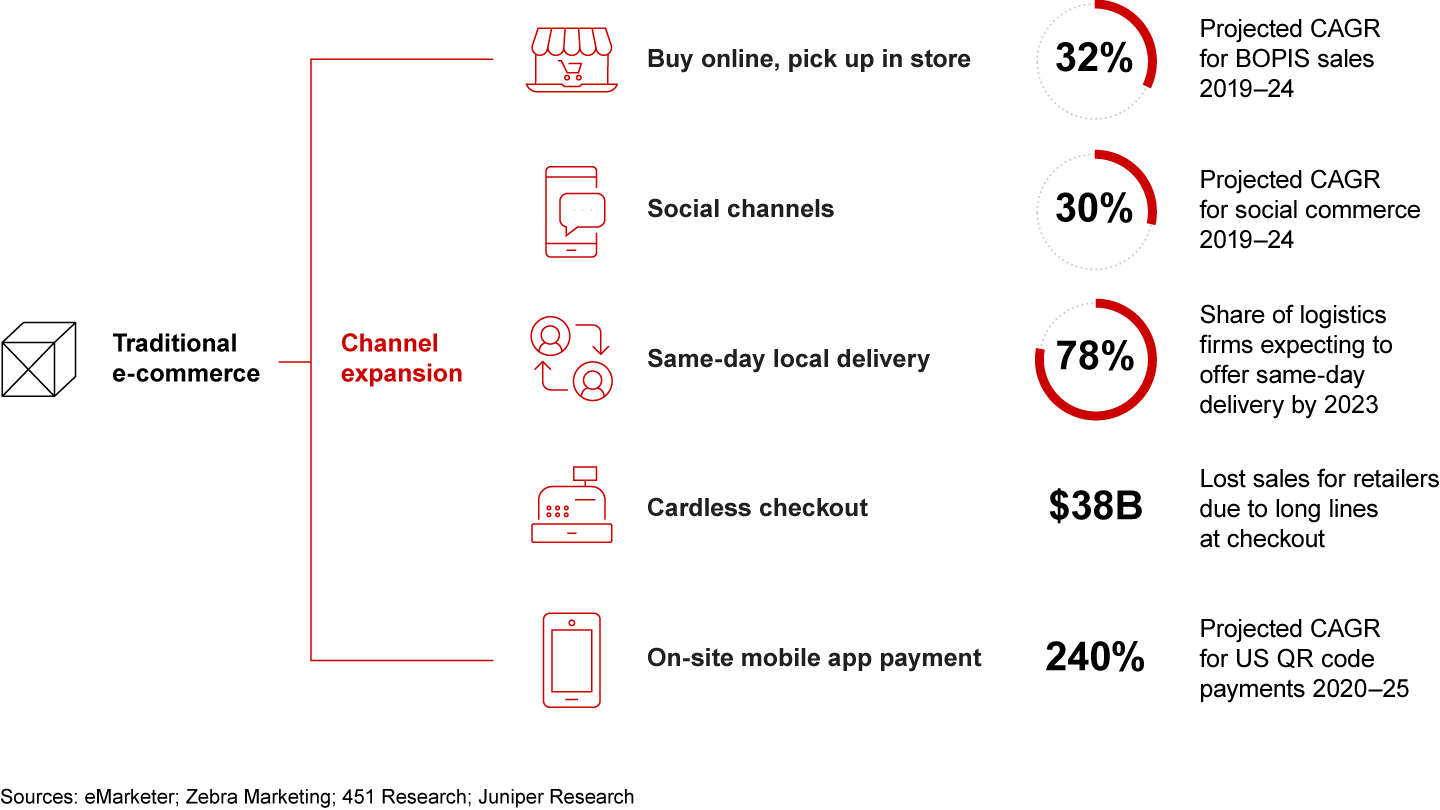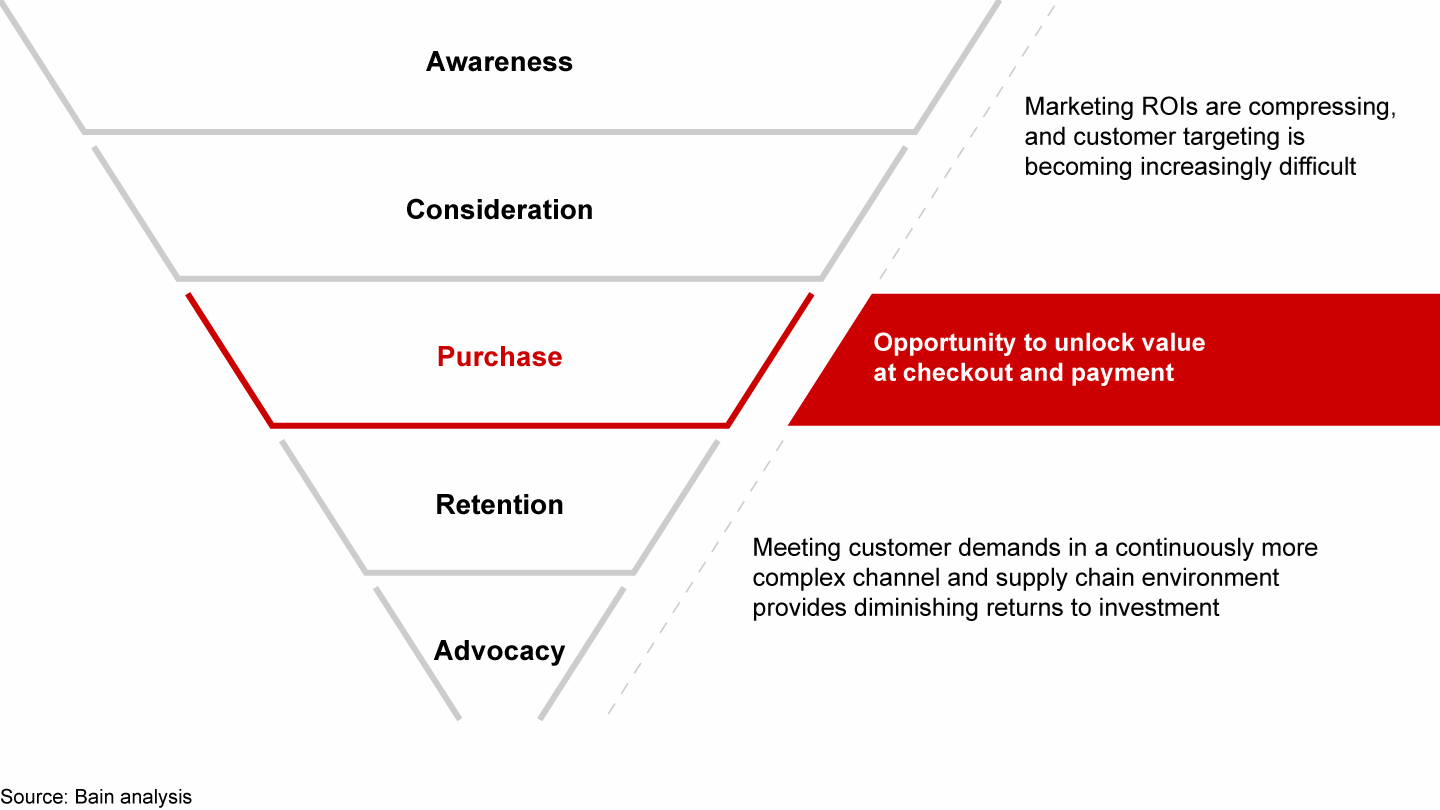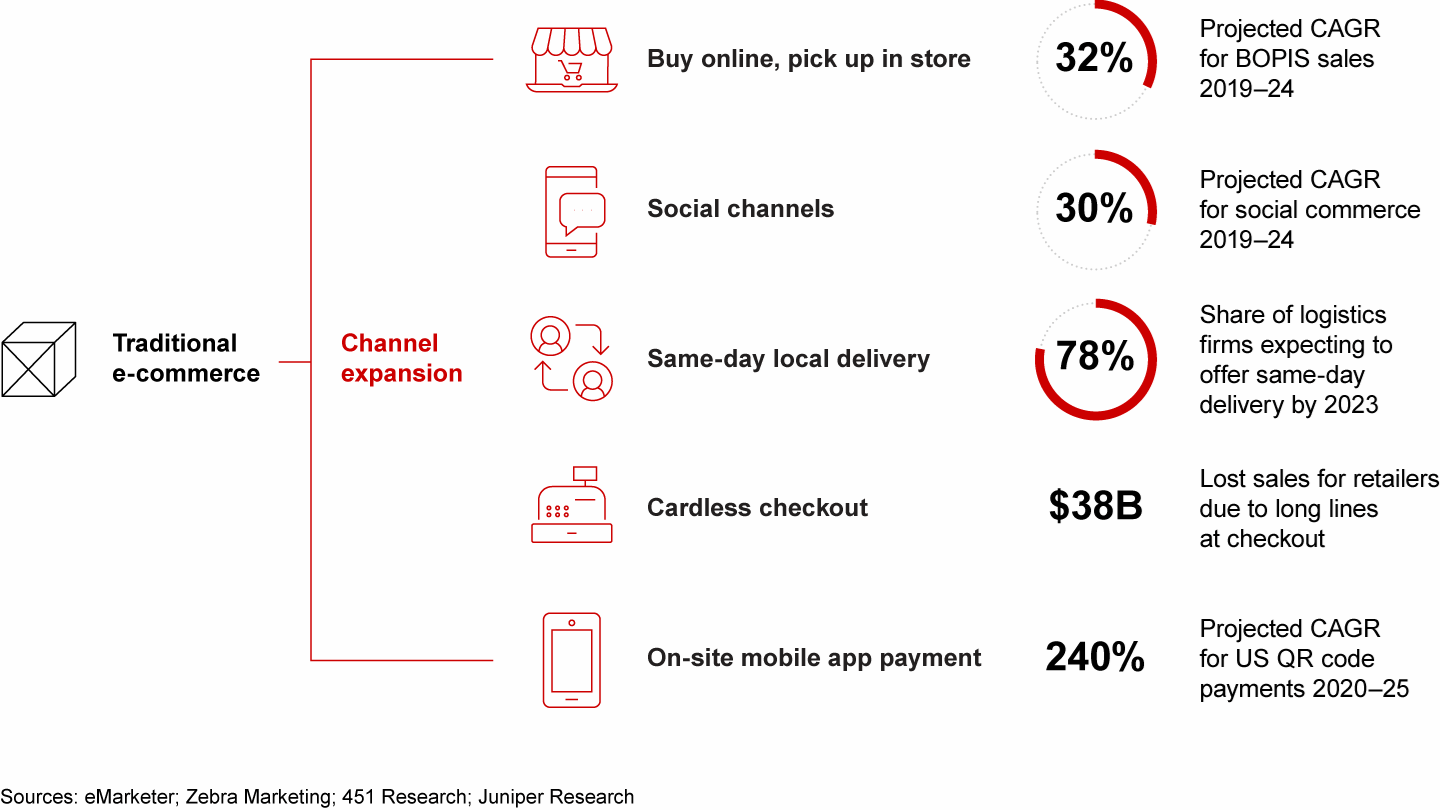Brief

한눈에 보기
- Meeting growth expectations has proven challenging for retailers, and rising fraud and abuse rates make it more difficult to balance growth and risk management.
- The checkout process is an often overlooked but vitally important area to capture value, but few retailers have the capabilities to improve it.
- By partnering with guaranteed payments companies, retailers can manage risk and ultimately boost their top and bottom lines.
Today’s retailers have been forced into a tough balancing act. They must deliver a seamless customer experience, accelerate growth, and maintain margins—all while vigilantly guarding against fraud. This situation is forcing trade-offs, with 55% of merchants saying their fraud-prevention approach makes it difficult to prioritize a smooth customer experience. While leaders like Amazon, which is growing at 2.5 to 3.5 times the rate of other retailers, don’t have to focus on optimizing, competitors remain pressured to manage this tricky balance.
Consolidation, increasing costs, and diminishing ability to find customers will continue to strain marketing returns on investment (ROI) as the customer acquisition cost rises. While the Covid-fueled boon to e-commerce is still relatively strong, sales are starting to dip. This, paired with today’s volatile macroeconomic environment, has only intensified pressure on retailers to find new sources of growth. The checkout process offers a prime opportunity for growth, but many retailers either overlook it or lack the capabilities to capture value there. Increasingly, they’re turning to third-party intelligence providers to help mitigate fraud, reduce checkout friction, and in turn, boost sales.
A confluence of pressures amid an uptick in fraud
Driving customer conversion from awareness to purchases and ultimately advocacy is challenging. Behemoths like Amazon, Facebook, and Google haven’t made it easier. Consistently growing marketing ROIs has become more challenging on many e-commerce sites, as advertising spending consolidates on the largest platforms (see Figure 1). Today, Amazon, Facebook, and Google make up 65% of digital ad spending—up from 63% in 2019. Amazon’s cost per click for ads increased 29% from January 2021 to July 2022. All of this has converged to drive up the cost of reaching customers.

At the same time, customer identification and targeting are becoming more challenging. Regulations, including the end of third-party cookies and new iOS features, have made it difficult to track location. Increasingly, desktop and mobile browsers are blocking third-party cookies by default. A full 75% of users do not allow iOS apps to track their activity across other apps and websites.
Adding to these obstacles is consumer demand for a frictionless purchase experience. While delivering a seamless experience has always been a priority, the scope is broader and more complex—and the cost of getting it wrong has never been steeper. Once narrowly defined as brand, retailer, and third-party websites, “online” shopping experiences now include a mix of other digital “customer not present” purchase mechanisms, like buy online, pick up in store (BOPIS), same-day local delivery, cardless in-store checkout, mobile payments, and purchase through social channels (see Figure 2). At a time when 39% of shoppers won’t shop with a retailer again after their payment has been declined, even minor friction points can be costly.

At the same time, fraudsters are innovating rapidly. In 2020, 59% of retailers reported an increase in card-not-present fraud. Further, the uptick in fraud is accelerating due to the rise in alternative payment methods like buy now, pay later (BNPL). Fraud losses are expected to increase 17% in 2023, to $48 billion from $41 billion in 2022. Retailers trying to balance maximizing approval and managing risks are finding traditional in-house fraud solutions increasingly strained by several factors.
- Approval timelines are compressing. Meeting shipping expectations requires rapid decision making that strains manual processes.
- Purchase volumes are more volatile. In addition to Black Friday, online volumes are concentrating around product launches, flash sales, heavy promotion periods (e.g., Prime Day), and even government subsidies.
- In-house solutions require hard-to-find talent. Artificial intelligence (AI) talent and labor for manual reviews are both difficult to recruit.
Retailers have an opportunity to drive additional value from payment optimization, but few are well positioned to unlock the benefits.
Fighting fraud with a third-party advantage
Increasingly, third-party solutions are filling the gaps left by the standard in-house fraud management approach. The current process allows revenue and cost leakage to occur in myriad ways: overcontrolling payment fraud and rejecting good transactions; introducing delays and labor to perform manual fraud reviews; and chargeback costs. The decisions made in this workflow can affect groups including marketing, treasury (payments), customer success, and ultimately finance.
Without one clear owner, the opportunity to improve payments handling often goes untapped. Unnecessarily declined transactions are particularly insidious. No competent retailer would allow a checkout line of frustrated customers to cross the street to a competitor. But in the effort to control e-commerce fraud, the virtual equivalent is often occurring unknowingly; good customers are being turned away at the transaction point and turned away before they can build off a longer-term relationship with the retailer.
Assessing risk using a network of data
For third-party solutions, retailers have a range of options. For each transaction, companies like Accertify and Kount derive an automated risk-score calculation from rules and machine learning algorithms. In return for a transaction fee, retailers can use this score to accept and decline transactions.
More sophisticated risk-scoring providers utilize data from across their retailer clients. While these solutions lessen retailers’ burden of manual review, they require significant resource investment for active management, as well as direct chargeback liability for the retailer. Guaranteed payments (GP) solutions such as Signifyd and Riskified allow brands and retailers to effectively outsource the management and liability for these risks. Depending on the specific procedure, retailers can eliminate the operating cost of legacy manual solutions while retaining fine-grained controls and business-specific logic.
GP providers leverage an unmatched pool of data across their retail network and third-party sources, alongside AI and machine learning technology. To align their interests with the retailer, these providers price on basis points of revenue, absorb the fraud chargeback costs, and guarantee a higher rate of checkout approvals than the retailer can achieve in-house, resulting in overall improved retail ROI.
While both approaches sound similar, except for which party bears the chargeback costs, that understanding misses an important consequence of the liability transfer. There’s an inherent challenge in maintaining a risk-scoring model. Vendors continually invent and add new rules to their models; however, the rules can’t always keep up with fraudsters’ evolving methods, resulting in good transactions being blocked. GP providers can freely experiment and approve transactions that their current models score as fraudulent to test the outcome and ultimately fine-tune the model. This is done at no cost, and in fact, grants the client a sale that wouldn’t have otherwise occurred. Another advantage? All of a GP provider’s clients benefit from this test-and-learn approach.
Powerful intelligence for meaningful impact
How can third parties create superior results? Retailers typically have access to purchase-specific data across the customer journey, including CRM records, device ID, browsing behavior, and payment information. GP providers, in contrast, see the whole picture: a unique view into the customer and the transaction, matching purchase data with network data from retailers globally (see Figure 3). On average, third-party providers use 50 to 100 data fields per person/transaction to inform decisions, drawing on everything from past devices and past payments to cross-site behavior.
As a result, GP providers have a significant advantage over traditional in-house models. In fact, a leading player like Signifyd often can deliver a one-time boost of “found growth” by increasing approval rates by 5% to 9% and decreasing costs of fraud and chargebacks by 55% to 95%. This enables higher sustained revenue and margins, with scale of impact varying by industry and retailer. Additionally, retailers derive value from the customer lifetime value of shoppers that would otherwise be lost in the e-commerce journey because of denied transactions.
North American retailer Hot Topic realized it needed to address the significant percentage of legitimate orders it was turning away due to misplaced fraud concerns. When the retailer engaged Signifyd, it gained access to a large network of merchants producing substantially more data than it had historically been able to access. This data, along with Signifyd’s decision guarantee, allowed Hot Topic to better differentiate between legitimate and fraudulent orders, resulting in the approval of 94% of the orders that would have previously been declined and a multimillion-dollar boost in annual revenue.
A compelling argument for enhanced capabilities
The checkout process in most retailers’ customer funnel is getting more complex and fraught with risk. Compounding this challenge is a scarcity of AI talent at a time when the insights that drive purchase experiences are most needed. Innovative providers will continue to find ways to use their customers’ collective intelligence, offering solutions that create a more personalized experience and maximize customer conversion.
To assess the value of a third party’s solutions, consider:
- What is the value of transactions turned down at your e-commerce site?
- What portion of these customers will not return to shop at your website as a result?
- How much is it worth to recapture a portion of declined transactions?
- Can your payments optimization and fraud-prevention technologies improve authorization rates from card-issuing banks to widen the revenue funnel?
- How are you managing abuse risk as consumers facing a recession pressure-test your system for “free” products?
Fraudsters never stop; they just move on to the next soft target. As your competitors adopt more sophisticated methods, you may become an easy mark. Shoring up a defense may mean augmenting your capabilities. In-house fraud management can be counterproductive, overcontrolling for fraud while tanking transaction completion rates. Guaranteed payment providers are a path to flip the story, providing access to best-in-class fraud prevention, approving more transactions, creating a positive checkout experience, and boosting the bottom line.

